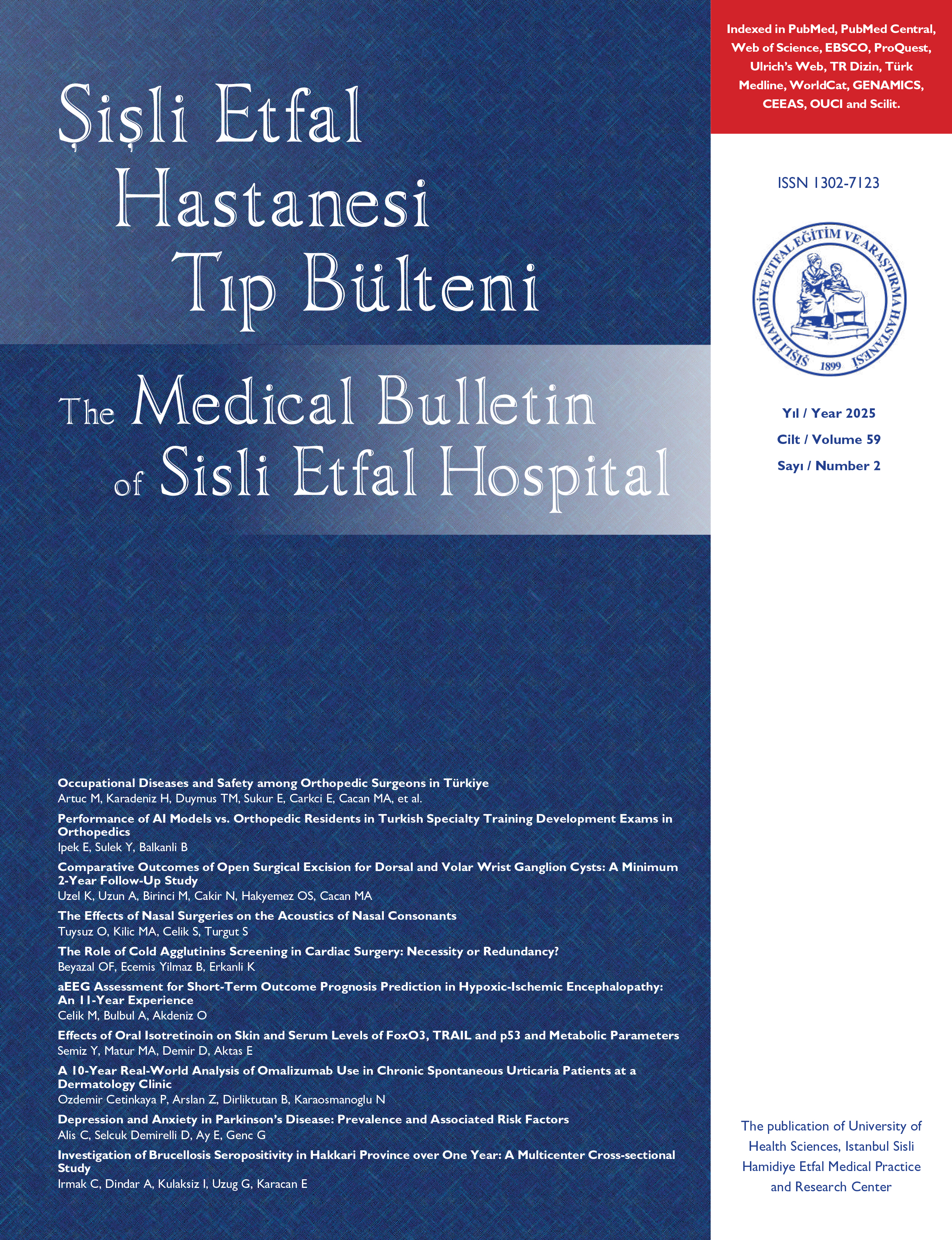
Impact of Extracorporeal Stent Placement during Laparoscopic Pyeloplasty on Operative Duration
Hasan Demirkan1, Kaya Horasanli21Türkiye Sağlık Bilimleri Üniversitesi, Kanuni Sultan Süleyman Eğitim ve Araştırma Hastanesi, Çocuk Ürolojisi Anabilim Dalı, İstanbul2Department of Pediatric Urology, University of Health Sciences Turkey, Sisli Etfal Training and Research Hospital, Istanbul, Turkey
Objectives: Ureteric stent insertion during laparoscopic pyeloplasty is the common practice for the reconstruction of ureteropelvic junction obstruction (UPJO). The long and hard learning curve of the method leads still controversy among surgeons. The utility of extracorporeal stent insertion in terms of shortening the length of operation time will be discussed in this study.
Methods: A total of 36 children who underwent pyeloplasty for UPJO were evaluated retrospectively. Indications for pyeloplasty were: Obstruction findings in renal scintigraphy, progressive kidney function loss, increasing in anteroposterior pelvis diameter in renal ultrasonography, and current clinical symptoms (febrile urinary tract infection and flank pain). Extracorporeal stent insertion procedure was performed as the following order: Ureteropelvic area and ureter were visualized transperitoneal by three trochars, and UPJO was excised. Thereafter, the ureter is taken out of the skin from pelvic trochar entrance and is spatulated. JJ stent is placed into the ureter. Following this move, the ureter is taken into the intra-abdominal area and first ureteropelvic suture is performed intra-abdominally.
Results: Thirteen of patients were girls and 23 were boys. Open surgery was applied for 15 patients (Group 1) and laparoscopic pyeloplasty (Group 2) to 21 patients. In Group 2, JJ stent was placed intracorporeally for six patients (Group 2a) and extracorporeally for the other 15 patients (Group 2b). The average age in Group 1 was 49.2±52 months; it was 86±29 months in Group 2a and 144±52 months in Group 2b, and the significant difference was present (p<0.001). There was statistically significant difference between Group 1 and Group 2 regarding with mean hospital stay (40 h in Group 1 and 42 h in Group 2; p=0.001). Post-operative JJ stent removal time was 58.8 days in Group 1 and 52.89 days in Group 2. In Group 2b patients, placing the stent extracorporeally took a significantly shorter operation time and the difference between the operation times of the groups (2a [192 min±3.76] and 2b [135 min±2.6] [p<0.001]) was statistically significant. No statistical difference was found between Group 1 (9.87±5.5 mm) and Group 2 (12.91±5.3 mm) in terms of renal anteroposterior diameters in the control ultrasonographic evaluation at the post-operative 2nd year (p=0.23). There was no difference between the two groups as a result of the evaluation of renal functions by scintigraphy at the post-operative 1st year (Group 1: 3.95±2%; and Group 2: 0.78±5.3%).
Conclusion: According to the consequences in this study, extracorporeally ureteric stent insertion during laparoscopic pyeloplasty shortens the length of operation duration so that extracorporeal insertion might be preferred in cases where it is difficult to place the stent during laparoscopic pyeloplasty.
Laparoskopik Pyeloplasti Operasyonunda Ekstrakorporeal Stent Yerleştirilmesinin Operasyon Süresine Etkisi
Hasan Demirkan1, Kaya Horasanli21Health Sciences University Kanuni Sultan Süleyman Training and Research Hospital.2Türkiye Sağlık Bilimleri Üniversitesi, Şişli Etfal Eğitim ve Araştırma Hastanesi, Çocuk Ürolojisi Anabilim Dalı, İstanbul
Amaç: Laparoskopik pyeloplasti sırasında üreter stenti takılması, üreteropelvik bileşke darlığının cerrahi tedavisi için yaygın olan bir uygulamadır. Yöntemin uzun ve zor olan öğrenme eğrisi, cerrahlar arasında hala tartışmalara yol açmaktadır. Ekstrakorporeal stent yerleştirilmesinin ameliyat süresinin kısalmasına katkısı bu çalışmada tartışılacaktır.
Yöntem: Üreteropelvik bileşke obstrüksiyonu nedeniyle pyeloplasti uygulanan 36 çocuk retrospektif olarak incelendi. Pyeloplasti endikasyonları şunlardır: Renal sintigrafide obstrüksiyon bulguları, progresif renal fonksiyon kaybı, renal ultrasonografide anteroposterior pelvis çapında artış, klinik semptomlar (ateşli idrar yolu enfeksiyonu ve yan ağrısı). Ekstrakorporeal stent yerleştirilmesi işlemişu sıraya göre yapıldı: üreteropelvik alan ve üreter 3 trokar ile transperitoneal olarak diseke edildi, üreteropelvik bileşke darlığı eksize edildi. Daha sonra, üreter pelvik trokar giriş yerinden dışarı alındı ve spatüle edildi. JJ stent ekstrakorporeal olarak üretere yerleştirildi. Takiben üreter batın içine alındı ve ilk üreteropelvik sütür batın içindeatıldı.
Bulgular: Hastaların 13'ü kız, 23'ü erkekti. On beş hastaya (grup 1) açık cerrahi, 21 hastaya laparoskopik pyeloplasti (grup 2) uygulandı. Grup 2'de JJ stent 6 hastaya (Grup 2a) intrakorporeal ve diğer 15 hastaya (Grup 2b) ekstrakorporeal olarak yerleştirildi. Yaş ortalaması grup 1de 49.2±52 ay; grup 2ada 86±29 ay ve grup 2bde 144±52 aydı ve anlamlı farklılık belirgindi (p<0.001). Ortalama hastanede kalış süresi açısından laparoskopik ve açık cerrahi yapılan hastalarda anlamlı fark vardı (grup 1'de 40 saat; grup 2'de 42 saat; p=0.001). Ameliyat sonrası JJ stent çıkarma süresi grup 1'de 58.8 gün ve grup 2'de 52.89 gündü. Grup 2deki hastalar arasında stentin ekstrakorporeal olarak yerleştirenlerde operasyon süresi belirgin kısaydı [2a (192 dakika ± 3.76) ve 2b (135 dakika ± 2.6) (p <0.001)]. Postoperatif 2. yılda kontrol ultrasonografik değerlendirmede böbrek anteroposterior çapları açısından grup 1 (9.87±5.5 mm) ve grup 2 (12.91±5.3 mm) arasında istatistiksel fark saptanmadı (p=0.23). Böbrek fonksiyonlarının postoperative 1.yılda sintigrafi ile değerlendirilmesi sonucunda da iki grup arasında fark yoktu (grup1: %3.95±2; grup 2: %0,78±5.3).
Sonuç: Çalışmamıza göre, laparoskopik pyeloplasti sırasında ekstrakorporeal olarak üretere stent yerleştirilmesi,ameliyat süresini belirgin kısaltmaktadır ve stentin yerleştirilmesinde zorlanıldığı durumlarda ekstrakorporeal olarak yerleştirme yapılması tercih edilebilir. (SETB-2020-06-106)
Manuscript Language: English



















